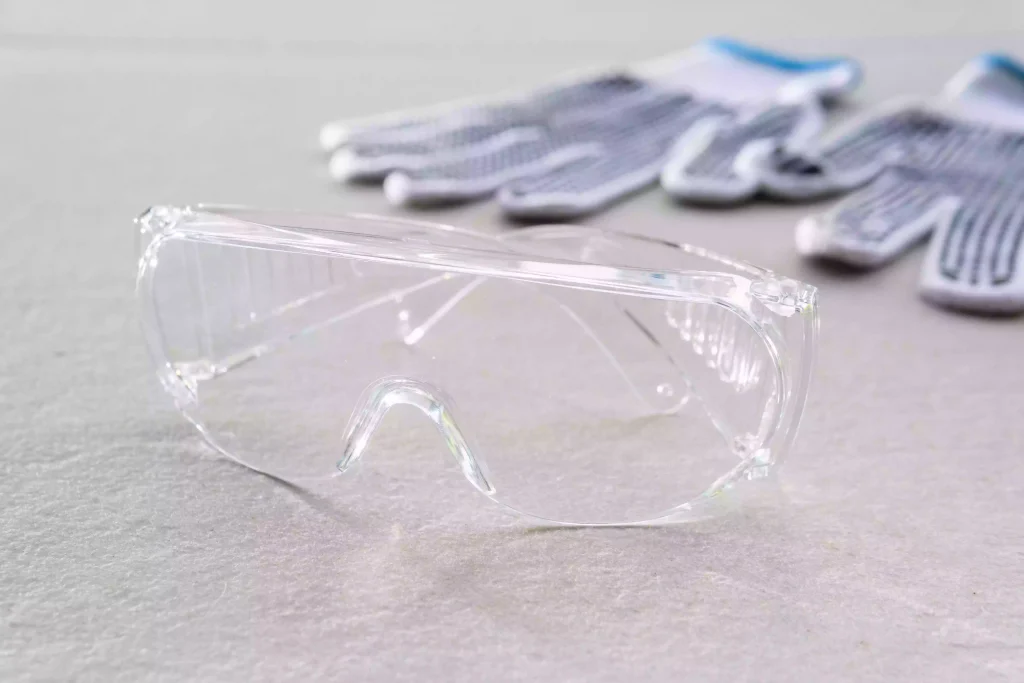When it comes to eye protection, both safety glasses and safety goggles are essential tools to guard against a variety of hazards. Whether you’re on a construction site, in a laboratory, or working with tools, eye protection is crucial to avoid injuries from flying debris, chemical splashes, or dust. But while both types of eyewear serve the purpose of protecting your eyes, they differ in how they provide that protection.
Choosing between safety glasses and safety goggles depends on the specific risks in your environment and the level of protection you require. This guide will explore the differences between these two types of eye protection, outlining the pros and cons of each to help you make the best decision for your needs.

Overview of Safety Glasses and Safety Goggles
Safety glasses are designed for comfort and convenience. They are lightweight and have side-arms, similar to regular glasses, which makes them easy to wear for extended periods. Safety glasses are commonly used in environments where flying debris is a risk, such as construction sites or workshops. They often come with features like UV protection, anti-fog coatings, and scratch-resistant lenses. However, safety glasses can leave gaps between the frame and your face, which means they may not protect against all hazards, especially fine particles or liquid splashes.
Safety goggles, on the other hand, provide a tighter fit around the eyes and form a seal to block out dust, liquids, and other fine particles. This makes goggles the preferred choice in high-risk environments, such as chemical laboratories or areas with a lot of airborne particles. Goggles are generally bulkier than safety glasses, and while they may not be as comfortable for long-term wear, their superior protection is often essential for certain tasks. Features like direct or indirect vents help prevent fogging while maintaining a snug fit, ensuring both safety and visibility.
Both safety glasses and goggles must meet safety standards such as ANSI (American National Standards Institute) ratings, which ensure they provide adequate mechanical strength and impact resistance. These ratings are important because they indicate the level of protection the eyewear can offer against various hazards. Depending on your specific activities, one type may be more suitable than the other.
Key Differences Between Safety Glasses and Safety Goggles
While both safety glasses and safety goggles serve the same purpose—protecting your eyes from potential hazards—their structural differences lead to varied levels of protection.
Fit and Coverage: Safety glasses rest on the nose and ears, leaving gaps around the eyes. These gaps can allow dust, chemicals, or other fine particles to reach your eyes, especially during more intense or high-risk tasks. Safety goggles, however, form a complete seal around the eyes, offering better protection against hazards like chemical splashes or flying particles. This seal is crucial in environments where there is a high risk of exposure to hazardous materials.
Comfort and Wearability: Safety glasses are lightweight and comfortable, making them ideal for jobs that require prolonged wear. Their design closely resembles regular eyeglasses, making them less intrusive and easier to wear with other protective equipment like helmets or hearing protection. Safety goggles, while offering superior protection, are generally bulkier and can feel less comfortable when worn for extended periods. However, newer models of goggles often include features like anti-fog coatings, direct or indirect ventilation, and softer materials to enhance comfort.
Specificity of Use: Safety glasses are best suited for environments where the primary risk is impact from flying debris or dust. They are also appropriate for general tasks like carpentry, construction, or working with power tools. Safety goggles are necessary in more hazardous situations where chemical splashes, fumes, or fine dust are present. They are commonly used in chemical labs, medical environments, and woodworking shops. For tasks that involve high exposure to risks, goggles offer the more comprehensive protection needed.
Protection Levels: Safety goggles offer superior protection because of their seal around the eyes. This makes them more effective in keeping out liquids, vapors, and fine particles. Safety glasses, while effective against larger debris and impacts, do not offer the same level of protection for finer particles or liquids due to the gaps around the sides.
Fogging Issues: One of the common problems with both safety glasses and goggles is fogging, which can obstruct vision. Safety glasses are less prone to fogging because they allow more airflow. However, safety goggles often have anti-fog coatings or ventilation systems that help reduce misting. Many goggles today are designed with direct or indirect vents that allow air circulation while still maintaining their protective seal.
Understanding the Purpose of Safety Glasse

Safety glasses are versatile and can be used in a variety of environments where eye protection is necessary but the risk of exposure to hazardous materials is low. They are typically used in construction, general manufacturing, and even laboratories, where the main risk is debris or minor impact rather than exposure to chemicals or fine particles.
Safety glasses can come with additional features like UV protection for outdoor use, anti-fog lenses, and prescription options. These glasses provide basic protection and are often preferred for light to moderate tasks because of their comfort and ease of use.
Understanding the Purpose of Safety Goggles
Safety goggles offer a much higher level of protection than safety glasses and are designed for environments where eye protection is critical. In situations where workers are exposed to chemicals, harmful dust, or potential liquid splashes, goggles provide a complete barrier around the eyes. This makes them ideal for use in laboratories, medical facilities, or any environment where chemicals are handled regularly.
Goggles may also be equipped with special coatings that prevent fogging, as well as vents to allow airflow while maintaining a secure fit. While they can be bulkier and less comfortable than safety glasses, the added protection they offer makes them essential in high-risk environments.
Safety Glasses vs. Safety Goggles: When to Use Each
The choice between safety glasses and safety goggles depends on the specific hazards present in your work environment.
Use Safety Glasses when the primary risk involves flying debris or objects. They are best for tasks like general construction, woodwork, or other low-risk activities where there is little to no risk of chemical exposure. Safety glasses are also a good option for outdoor work that requires protection from UV rays.
Use Safety Goggles when working in environments that involve chemicals, dust, fumes, or other small particles that could enter your eyes. Goggles are ideal for tasks like handling hazardous chemicals, sanding, grinding, or working in laboratories. They provide the most comprehensive eye protection and are required in situations where there is a significant risk of exposure to harmful substances.
Pros and Cons of Safety Glasses and Safety Goggles
Pros of Safety Glasses:
- Lightweight and comfortable for extended wear
- Easy to pair with other protective equipment
- Offers good protection against larger debris
- Often includes features like UV protection and anti-fog coatings
Cons of Safety Glasses:
- Leaves gaps around the eyes, allowing dust and liquids to enter
- Not suitable for environments with high chemical exposure
Pros of Safety Goggles:
- Provides complete eye protection with a sealed fit
- Ideal for environments with chemicals, dust, or fine particles
- Often includes anti-fog technology and ventilation systems
Cons of Safety Goggles:
- Bulkier and may be uncomfortable for long periods of wear
More expensive than safety glasses
Conclusion
In the end, the decision between safety glasses and safety goggles comes down to the level of protection you need for your work environment. Safety glasses are great for everyday tasks where the risks are lower, while safety goggles are necessary in high-risk environments where complete protection is required.
Ensure that your choice of eye protection meets the safety standards for your specific industry, and remember that comfort and proper fit are just as important as protection. By selecting the right eyewear, you can protect your eyes effectively while working comfortably, no matter the environment. Choose real high-quality wholesale safety glasses at Optics Town!
FAQ
What is the main difference between safety glasses and safety goggles?
Safety glasses have shatter-resistant lenses and provide front protection, suitable for general use. Safety goggles offer a sealed fit around the eyes, protecting against dust, splashes, and chemicals. Use safety glasses for light tasks and goggles for more hazardous environments.
In what situations should I wear safety goggles instead of safety glasses?
Wear safety goggles instead of safety glasses in situations where there’s a risk of splashes, dust, or flying particles, such as when working with chemicals, grinding, or woodworking. Goggles provide a tighter seal and better protection against these hazards.
Are safety glasses as protective as safety goggles?
Safety glasses provide basic eye protection against flying debris but do not seal against dust or chemicals. For full protection, especially in hazardous environments (e.g., labs, construction sites), use safety goggles that form a snug fit around the eyes. Always select appropriate eyewear based on the specific hazards.
How do I choose the right type of eye protection for my specific needs?
Identify your activity (e.g., sports, construction, lab work). Choose lenses with appropriate UV protection for outdoor activities or safety glasses with impact resistance for construction. For lab work, use goggles for chemical protection. Always ensure a proper fit for maximum protection and comfort.
Can safety glasses and goggles be worn together for additional protection?
Yes, safety glasses and goggles can be worn together for added protection, especially in environments with flying debris or hazardous materials. Ensure the goggles fit securely over the glasses without obstructing vision. For example, use ANSI-rated safety glasses under industrial goggles during construction or lab work.




